8 Best Practices for Efficient Ecommerce Inventory Management
Real estate properties with high-definition photos receive more online views, sell faster, and yield higher prices. This guide explores the nuances of real estate photo editing and retouching technology to meet ever evolving buyer expectations.
Table of Contents
Captivating catalog images are the gateway to creating lasting first impressions in the real estate industry. These images, however, don’t just come to life with a simple click of the camera. Buyers spend 60% of their time checking images and only 20% on property descriptions. They are the result of meticulous property photo editing and retouching, transforming ordinary photos into extraordinary ones that highlight the unique features of a property and attract potential buyers.
Properties listed with HD quality photos receive 118% more online views, sell 32% faster, and yield 47% higher prices.
Creating such impactful images is a delicate blend of art and precision aimed at showcasing the property in its best light while maintaining its authenticity. It’s about making the images inviting and relatable, allowing viewers to envision themselves in the space, feeling the warmth of the living room, or the tranquillity of the garden.
Explore the nuances of property photo editing and retouching further through this guide, which provides real estate professionals, photographers, and enthusiasts with valuable insights into the methods and innovations in representing properties visually. Discover how these real estate photo editing techniques can turn every image into an interesting visual story, opening doors to more inquiries, viewings, and successful sales.
We explore these two integral processes of property image editing in our detailed guide and demonstrate how they can be utilized together or separately to increase the property appeal.
The evolution of property image editing techniques has provided real estate professionals with a competitive edge by enabling them to create high-quality, visually appealing images that attract potential buyers. As technology continues to advance, it is likely that new techniques and tools will further enhance the capabilities of real estate professionals in showcasing properties.
| Era/Technique | Description | Impact on Real Estate Industry |
|---|---|---|
| Conventional Techniques | Description Before the digital age, they edited photos using darkroom manipulation, film, and negative adjustments. | Impact on Real Estate Industry Labor intensive methods required specialized skills, restricting number of employed professionals |
| Color Photography Influence | Description Color photography introduced techniques like color correction and color grading. | Impact on Real Estate Industry Color photography introduced techniques like color correction and color grading. |
| Digital Photo Manipulation | Description Software like Photoshop and Lightroom revolutionized photo editing, making it more accessible and efficient. | Impact on Real Estate Industry Digital manipulation helped produce high-quality images, drawing in potential buyers. |
| Advancements in Technology | Description Advancements in Technology | Impact on Real Estate Industry New innovations now offer immersive experiences for potential buyers, setting properties apart from each other. |
Professional real estate photo editing aspires to make a listing stand out amidst a sea of options, offering realtors not just an aesthetic edge, but a strategic advantage in captivating the discerning eyes of potential buyers.
Property photo editing and retouching have huge importance in the real estate industry. But their applications differ from each other along with their outcome. Property photo editing refers to the process of making alterations to an image to improve the overall quality and composition of the property images.
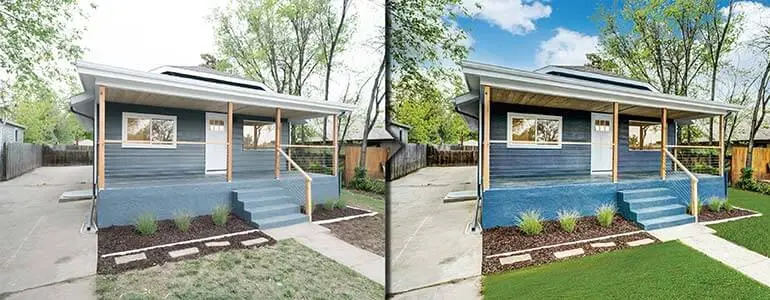
Retouching, on the other hand, focuses on refining specific details in an image, often to remove imperfections or enhance certain features. Together, they ensure that property photos are both technically sound and aesthetically appealing. Here is a table that explains the concepts better:
| Criteria | Photo Editing | Photo Retouching |
|---|---|---|
| Definition | Photo Editing Altering an image to improve its overall appearance. | Photo Retouching Refining and enhancing specific details of an image. |
| Purpose | Photo Editing To make the image look more appealing and accurate by adjusting colors, brightness, contrast, etc. | Photo Retouching To correct specific imperfections or enhance certain features of the property. |
| Techniques Used | Photo Editing Cropping, resizing, color correction, brightness/contrast adjustment, etc. | Photo Retouching Removing blemishes, enhancing textures, smoothing out surfaces, etc. |
| Tools Commonly Used | Photo Editing Photoshop, Lightroom, GIMP, etc. | Photo Retouching Photoshop, Lightroom, GIMP, etc. |
| Time Consumption | Photo Editing Quicker, as it involves broad adjustments to the entire image. | Photo Retouching Can be time-consuming as it deals with specific details and requires precision. |
| Common in Real Estate for | Photo Editing Adjusting the lighting of a room, enhancing the sky in exterior shots, correcting lens distortion. | Photo Retouching Removing unwanted objects, enhancing the glow of a fireplace, highlighting specific architectural details. |
| Outcome | Photo Editing A more visually appealing and balanced image that represents the property well. | Photo Retouching A polished image with enhanced details and no visible imperfections. |
Every property has a story to tell, and the medium of this narration is often visual. But, like every good story, the narrative is only as interesting as its presentation. Photo editing and retouching step in to not only make a space look good; they aspire to capture its essence, highlight its potential, and present it that resonates with potential buyers.
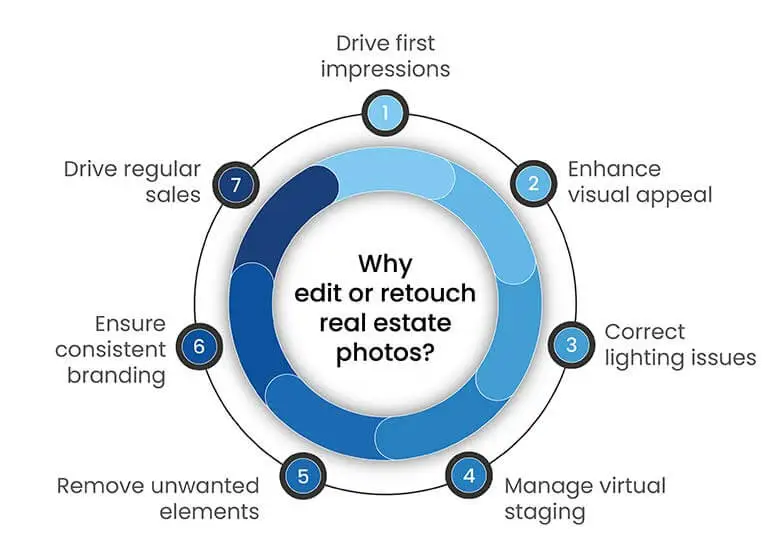
First impressions matter:
In the digital age, a property’s first impression is often through its photos. High-quality images act as a magnet, ensuring that a property doesn’t just blend into the background but commands attention, enticing potential buyers to explore further.
High-quality photo editing generated impeccable digital catalogs for real estate photographers and videographers. This not only resolved imperfections in the raw images, but also enhanced their brand value.
Enhance visual appeal:
Beyond mere aesthetics, photo retouching can artfully stress the unique architectural details, lush landscapes, or intricate interiors of a property. This not only elevates its visual allure, but can significantly boost its perceived market value.
Correct lighting issues:
Lighting can make or break a photo. Professional editors illuminate gloomy corners, soften harsh shadows, and create a warm and inviting ambiance in rooms, mirroring a real-life walkthrough experience.
Virtual staging:
The magic of digital furnishing can transform an empty space into a vibrant living area. Virtual staging paints a picture of possibility, allowing buyers to dream and see beyond the bare walls and imagine a life within.
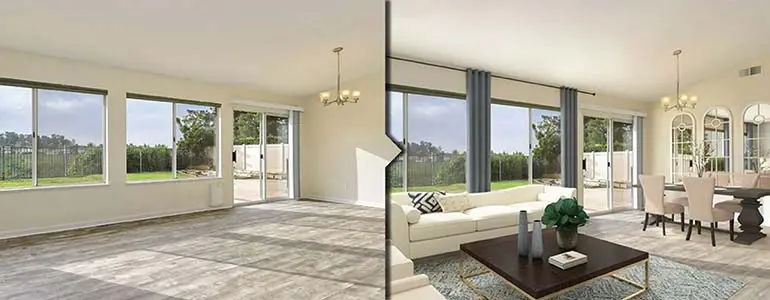
Remove unwanted elements:
Every property has its quirks. Professional real estate photo editing seamlessly erases unsightly power lines crisscrossing the sky, stray garbage bins, or minor wall blemishes, presenting a pristine image without distractions.
Consistent branding:
For real estate firms, consistency is key. Uniformly edited photos ensure that every listing, regardless of its location or price range, resonates with the company’s signature style, building trust and reinforcing brand recognition.
Increase sales:
A picture is worth a thousand words, and in real estate, it could be worth thousands of dollars. Captivating images can spark more inquiries, lead to increased property viewings, and, ultimately, expedite sales.
Cost-effective:
Sometimes reshooting is not an option. Maybe the property is no longer accessible, or the weather refuses to cooperate. In such cases, professional photo editing emerges as a cost-effective savior, rectifying issues with no costly reshoot.
360-degree virtual tours:
The future of property viewing is virtual. Through meticulous photo stitching and editing, buyers can embark on a 360-degree journey, navigating through properties from different continents, all from the comfort of their couches.

Timesaving:
The unpredictability of natural elements can be a photographer’s bane. But with professional editing, real estate agents no longer need to be at the mercy of the golden hour or a clear sky. They can shoot at their convenience, confident that editing will bridge the gap between reality and perfection.
Cost implications:
The real estate market is competitive, and every penny counts. While high-quality photo editing is an investment, it’s essential to strike a balance. Ensuring top-notch visuals without overshooting the budget requires careful consideration, making it imperative to choose photo editing services that offer value for money.
Need to get your real estate photo editing and retouching needs fulfilled?
Ensuring professional quality in image editing and retouching in real estate projects is paramount to the industry’s success. Unfortunately, there is a lack of standards and metrics that many editors cannot follow.
Property photo editing involves striking a delicate balance between art and accuracy. While the goal is to present properties in the best possible light, there’s a fine line between enhancement and misrepresentation. As professionals strive to perfect property images, they often encounter a myriad of quality issues that can detract from the image’s authenticity and appeal.
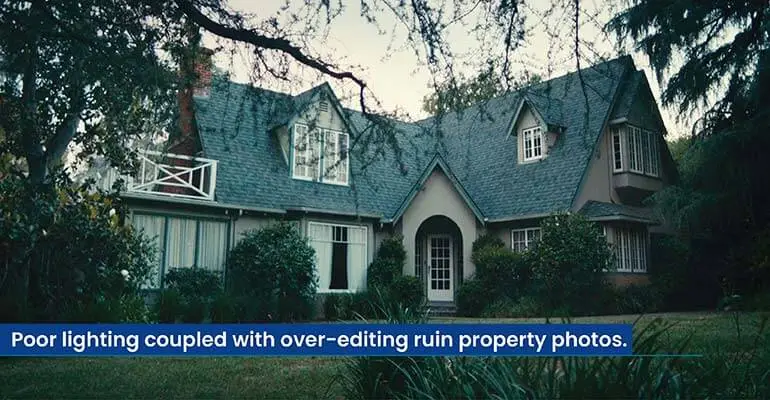
Let’s focus on these common challenges and understand their impact on property photography.
Because images often serve as the first point of contact between properties and potential buyers, the quality of photo editing decides what elements can make or break a sale. To ensure a sale, it’s equally crucial to have images that are professionally edited, authentic, aligned with the client’s vision, and capture the property’s essence. Here’s a comprehensive guide to meeting quality metrics in real estate photo editing:
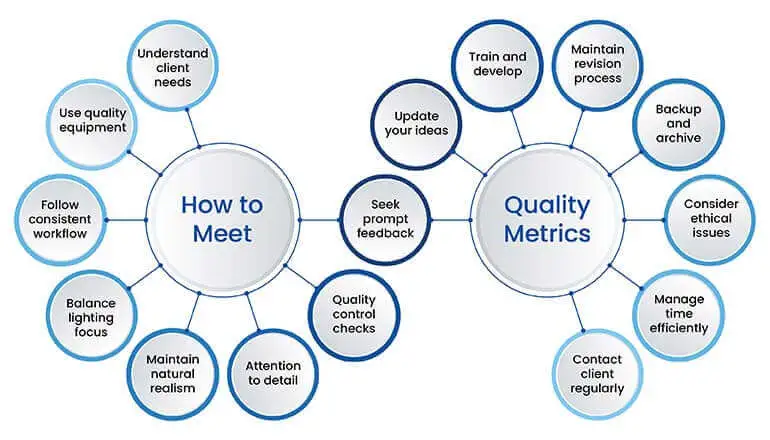
While the aim of photo editing is to enhance and elevate, it’s easy to step into pitfalls that can disrupt the harmony of the images. These missteps not only detract from the property’s appeal, but can also mislead potential buyers.
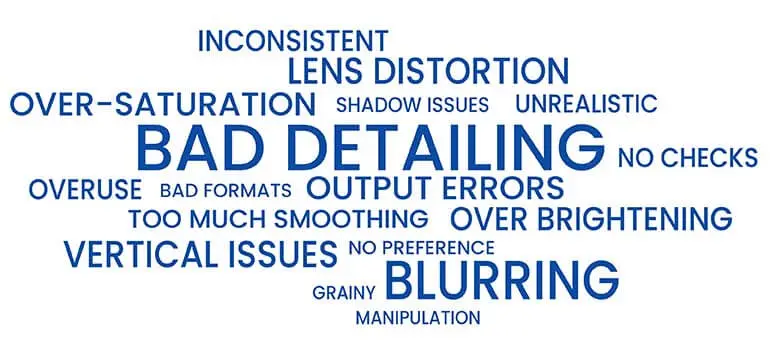
Let’s focus on the common mistakes that can hinder consistency and how to avoid them:
Read our article about top 5 real estate photo editing mistakes that hurt property listings for a detailed explanation.
Popular software used by professional property photo editors
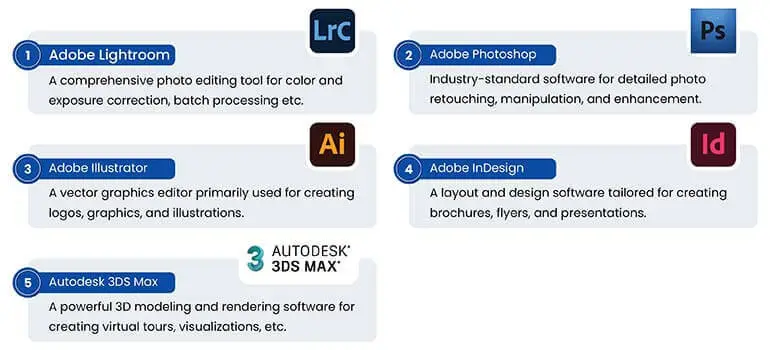
Photo editing tools have come a long way in enhancing and editing property photos. The results are realistic and refined, offering a chance for property owners to represent their properties in the best possible light. Here is how these tools help achieve professional editing results, of course, with the help of a professional photo editor.
By leveraging the capabilities of these tools, real estate professionals can ensure that their property photos are not only of high quality but also effectively presented to potential buyers.
Advanced tools and software play a pivotal role in determining the quality and efficiency of the final output. As technology advances, software developers continually refine and enhance their products, releasing newer versions that are packed with improved features, bug fixes, and optimizations. For professionals in the realm of property photo editing, keeping software updated by embracing these version upgrades is not just a recommendation; it’s a necessity. Here’s why:
How to take care of software updates
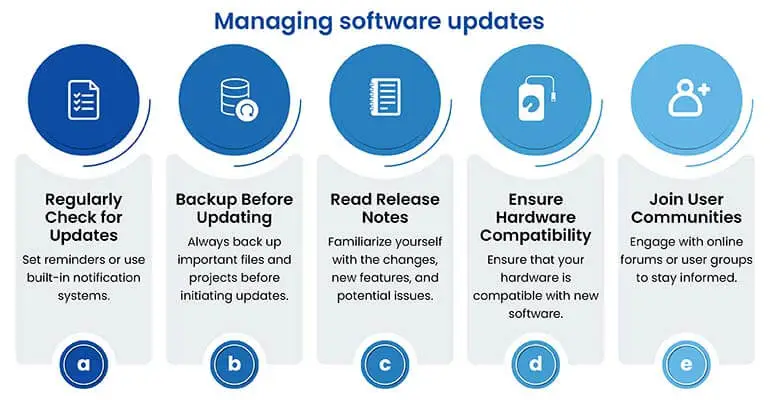
As we stand on the cusp of a new era marked by rapid technological advancements, the landscape of property image editing is undergoing transformative changes. Here’s a deep dive into the emerging trends and how they’re reshaping the industry:
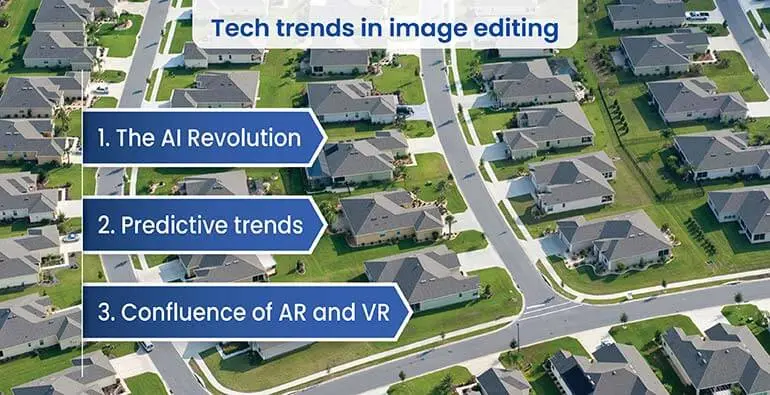
Artificial intelligence (AI) is no longer the stuff of science fiction. It’s here, and it’s making waves in the world of photo editing. With the power of machine learning, AI tools can now automatically enhance photos by adjusting lighting, correcting color imbalances, and even removing imperfections. But it doesn’t stop there. AI can analyze the content of an image and suggest edits tailored to it. For instance, if a property photo showcases a living room, AI can suggest brightness adjustments that highlight the room’s cozy ambiance. This not only streamlines the editing process, but also ensures optimal results with minimal human intervention.
The future of property image editing is not just about reacting to current needs, but also anticipating them. Emerging trends include automated staging solutions powered by AI. Imagine uploading an empty room’s photo and having AI suggest and virtually place furniture that complements the room’s dimensions and style. Beyond just placement, AI can also predict and suggest edits based on current market preferences. If minimalist interiors are trending, the system might suggest edits that align with that aesthetic, ensuring that property images resonate with potential buyers.
Augmented Reality (AR) and Virtual Reality (VR) are changing the game in property imaging. Gone are the days when potential buyers have to rely solely on static images or videos to get a feel of a property. With AR and VR, they can embark on immersive virtual tours, exploring every nook and cranny of a property from the comfort of their homes. These virtual walkthroughs offer a 360-degree visualization of spaces, allowing buyers to experience properties in a way that static images never could. For realtors and property sellers, this means an enhanced ability to showcase properties, highlight unique features, and offer a more engaging viewing experience.
The future of property photo editing and retouching is intertwined with technological advancements. As AI, AR, and VR continue to evolve, they offer tools and possibilities that were once deemed impossible. For professionals in the industry, staying abreast of these trends is not just beneficial—it’s essential to remain competitive and deliver cutting-edge results in a market that’s constantly in flux.
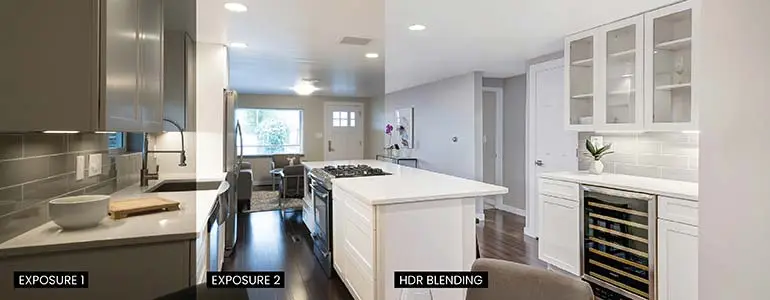
Countless property listings converge into a single platform for real estate data aggregators. These images serve as the first impression for potential buyers, setting the tone for their property exploration journey.
However, real estate data aggregators, who are at the forefront of collecting and presenting these listings, often grapple with myriad challenges related to property photo editing:
Apart from the above mentioned benefits, professional real estate photo editing services can save photographers up to 60% of image editing expenses if they outsource these tasks.
Outsourcing real estate image editing to third-party service providers ensures high-quality, professional results, enhancing property appeal to potential buyers. While cost efficiency is a significant advantage, outsourcing also eliminates the need for in-house editing teams and associated expenses. The partnership provides access to the latest editing tools and techniques without the need for direct investment. Additionally, it offers scalability, and enables flexibility to handle fluctuating project volumes without compromising quality or turnaround time.
Here’s a quick comparison outlining the differences between in-house and outsourced real estate photo editing and retouching:
| Aspect | In-House Real Estate Photo Editing | Outsourced Real Estate Photo Editing |
|---|---|---|
| Cost | In-House Real Estate Photo Editing Higher due to salaries, software, and equipment. | Outsourced Real Estate Photo Editing Lower, as it eliminates the need for in-house resources. |
| Expertise | In-House Real Estate Photo Editing Limited to the skills of in-house staff. | Outsourced Real Estate Photo Editing Limited to the skills of in-house staff. |
| Equipment & Software | In-House Real Estate Photo Editing Requires investment in the latest tools. | Outsourced Real Estate Photo Editing Service providers use their own advanced tools. |
| Scalability | In-House Real Estate Photo Editing Limited by staff and resources. | Outsourced Real Estate Photo Editing Highly scalable to handle fluctuating workloads. |
| Time Efficiency | In-House Real Estate Photo Editing Can be slower due to other responsibilities. | Outsourced Real Estate Photo Editing Faster turnaround as they focus solely on editing. |
| Quality Control | In-House Real Estate Photo Editing Dependent on in-house expertise and workload. | Outsourced Real Estate Photo Editing Consistently high-quality due to specialized focus. |
| Flexibility | In-House Real Estate Photo Editing Limited by in-house capabilities. | Outsourced Real Estate Photo Editing More flexible, offering a range of services and styles. |
| Focused Approach | In-House Real Estate Photo Editing Takes focus away from core real estate activities. | Outsourced Real Estate Photo Editing Allows real estate businesses to focus on core operations. |
| Training & Development | In-House Real Estate Photo Editing Requires ongoing training for staff. | Outsourced Real Estate Photo Editing Outsourced teams are already trained and updated on latest developments in tools, technology and industry knowledge. |
Image editing and retouching have emerged as indispensable approaches for property photo editing. They play a pivotal role in shaping perceptions, enhancing property appeal, and ultimately influencing buying decisions. A well-edited image has the ability to transform an ordinary property into an extraordinary visual experience, capturing the imagination of potential buyers and setting the tone for property value and desirability.
For real estate professionals, investing in quality image editing services is not just a choice – it’s a strategic move toward achieving better outcomes. As the adage goes, “A picture is worth a thousand words,” and in the real estate domain, it could very well be worth thousands of dollars. With rapid advancements in image editing technology, from AI-driven enhancements to immersive AR and VR experiences, the possibilities are limitless. Embracing these technological innovations ensures that property listings are not only visually compelling but also aligned with the evolving expectations of today’s discerning buyers.
What’s next? Message us a brief description of your project.
Our experts will review and get back to you within one business day with free consultation for successful implementation.
Disclaimer:
HitechDigital Solutions LLP and Hitech BPO will never ask for money or commission to offer jobs or projects. In the event you are contacted by any person with job offer in our companies, please reach out to us at info@hitechbpo.com
Leave a Reply